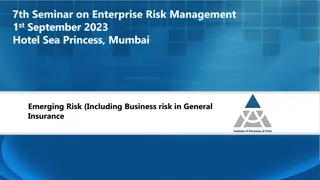Navigating High-Risk Ventures in Capital Markets
Exploring the complexities of high-risk investments, including risk tolerance evaluation, diversification, and professional advice for successful ventures. Dive into the deep end of investing carefully with key considerations.
Download Presentation
Please find below an Image/Link to download the presentation.
The content on the website is provided AS IS for your information and personal use only. It may not be sold, licensed, or shared on other websites without obtaining consent from the author. Download presentation by click this link. If you encounter any issues during the download, it is possible that the publisher has removed the file from their server.
Presentation Transcript
Taking the Risk- When and How to Jump in the deep end of High-Risk Ventures Dickson Ssembuya, CFA Director Research and Market Development
Presentation Outline 1. 2. 3. 4. 5. 6. 7. 8. 9. Background Key Considerations Before Investing Investor Types And Their Risk Profile Importance of Understanding Personality Emotional bias in behavioral finance Strategies to Overcome Emotional Biases Why Understanding Investment Risks Is Important Importance of Getting Investment Advice Importance of Carrying Out Due Diligence
Background Investing in high-risk ventures within capital markets can be both thrilling and daunting. It involves a delicate balance substantial returns and the inherent uncertainties and volatility associated with high-risk assets. Understanding when and how capital markets investors should dive into the deep end of high-risk ventures requires a nuanced approach. After deciding how much risk is acceptable in a portfolio by acknowledging the time horizon and bankroll, one can use the investment pyramid approach for balancing their assets. between the pursuit of
Key Considerations Before Investing Risk Tolerance: Evaluate your comfort zone in taking on risk. Understand your willingness and ability to withstand potential investment losses, as high-risk ventures can lead to significant fluctuations in value and potential loss of capital. Financial Goals and Time Horizon: Consider your financial goals and investment time horizon. High-risk ventures may be suitable for long- term financial goals, but may not be appropriate for short-term objectives. Assess whether the potential returns align with your investment timeline Diversification: Understand the importance of diversification to reduce risk. Consider spreading investments across different asset classes and ventures to mitigate the impact of any single investment's performance on the overall portfolio
Key Considerations Before Investing Contd Understanding the Investment: Fully comprehend the nature of the high-risk venture, including the underlying business model, market dynamics, and potential for returns. Thoroughly research the investment opportunity and assess its viability Exit Strategy: Evaluate the ease Understand the liquidity of the investment and the potential challenges associated with realizing returns from high-risk ventures Professional Advice: Consider professionals or investment advisors. Professional guidance can provide valuable insights and help assess the suitability of high-risk ventures based on individual financial circumstances and goals of exiting the investment. seeking advice from financial
Investor Types And Their Risk Profile Contd Conservative Investors: These investors take low risks, focus on safe investments such as government bonds, fixed deposits, and debt funds, and prioritize stable returns over higher returns. They are risk- averse and prefer to invest in low-risk investment products Moderate Investors: These investors are willing to take moderate risks that do not jeopardize their life. They prefer to invest in balanced mutual funds and are comfortable with moderate volatility and risk of principal loss Aggressive Investors: These investors have a high willingness and ability to take risks and are best advised to invest in aggressive risk category products such as equity mutual funds and direct equity. They are comfortable with high levels of risk and are willing to potentially lose a lot of money to earn a higher return
Importance of Understanding Personality Risk Tolerance: Personalities vary in risk tolerance. Understanding one's risk tolerance is crucial for selecting investments that align with individual comfort levels. Time Horizon: Different personalities have different time horizons for their financial goals. Understanding this helps tailor investment strategies to meet specific timeframes. Emotional Resilience: Knowing how emotions impact decision-making allows investors to develop strategies to stay disciplined during market volatility. Communication Style: Effective communication between advisors and investors is key. Understanding communication styles ensures a productive and collaborative relationship. Financial Goals and Values: Personalities influence financial goals and values. Aligning investments with these goals fosters a sense of purpose and satisfaction.
Emotional Bias In Behavioral Finance Emotional significant role in influencing investment decisions. These biases are rooted in personal feelings and can lead to irrational decision-making. Here are some emotional biases in investing and strategies to overcome them: biases play a common
Emotional Bias In Behavioral Finance Contd Confirmation Bias: This bias leads investors to seek out information that confirms their existing beliefs, even if the information is incorrect. For example, an investor may hold onto a stock despite deteriorating fundamentals, anchoring on the initial purchase price Framing Bias: This bias occurs when investors make decisions based on how information is presented rather than the actual information itself Overconfidence Bias: Investors may overestimate their ability to predict market movements, leading to excessive trading and increased risk Loss Aversion Bias: This bias causes investors to feel a greater emotional effect from a loss than an equal value in gain, leading to reluctance to sell a stock at a loss Herding Bias: Investors tend to follow the actions of a larger group, leading to decisions based on the actions of others rather than individual analysis Regret Aversion Bias: This bias leads to a tendency to do nothing due to fear of making the wrong decision
Strategies to Overcome Emotional Biases Recognize Emotional Biases: Acknowledge common biases like loss aversion and overconfidence, as these emotions can cloud judgment and lead to impulsive decisions Set Clear Goals: Define financial goals clearly to make rational choices that align with aspirations Consult a Financial Advisor: Seek advice from a professional to obtain an objective perspective free from emotional biases Diversify Investments: Spreading risk through diversification can reduce emotional stress when markets fluctuate Stay Informed: Knowledge is a powerful tool against emotional biases. Stay informed about financial matters to make more confident decisions
Why Understanding Investment Risks Is Important Understanding involved crucial for making informed investment decisions achieving financial goals. Investment risks refer to the degree of uncertainty and potential financial loss inherent in an investment decision the risks in investing is and long-term
Why Understanding Investment Risks Is Important Risk and Reward: The level of risk associated with a particular investment or asset class typically correlates with the level of return the investment might achieve. Investors willing to take on risky investments and potentially lose money should be rewarded for their risk Diversification: Investors are able to diversify their portfolios by allocating assets across different asset classes and investment products. Diversification can help reduce the overall risk of the portfolio Risk Management: Investors are able to manage their risks by identifying potential risks and developing strategies to mitigate them
Why Understanding Investment Risks Is Important Cont d Investment Goals: Investors are able to align their investment choices with their financial goals and risk tolerance. Investors can choose investment products that match their risk profile and investment objectives Market Fluctuations: Investors are able to prepare for market fluctuations and volatility. Investors can make informed decisions during market downturns impulsive decisions based on emotions and avoid making
Investment Scams Hallmarks of investment scams include: a.High returns with low risk b.Pressure to act quickly c.Unregistered and unlicensed d.Lack of transparency e.Complex strategies f. Fake testimonials g.Cold calls
Investment Scams: How to Protect Yourself Educate yourself Check the background of sellers
Importance of Carrying Out Due Diligence Investigation of an investment opportunity before making a decision to invest. Due diligence seeks to gather information, assess the facts before making a decision. Risk Mitigation: Thorough research minimizes the risk of investing in assets or ventures with inadequate potential or excessive risk. Understanding Investments: Due diligence helps investors understand the nature of their investments, including potential returns and associated risks. Financial Health Assessment: Analyzing financial statements and performance metrics aids in assessing the financial health of companies or investments. Legal and Regulatory Compliance: Due diligence ensures that investments comply with relevant legal and regulatory requirements, reducing the likelihood of legal issues. Identifying Red Flags: Rigorous research helps investors identify any red flags or warning signs associated with an investment.
Importance of Getting Investment Advice Expertise knowledge to the table, helping investors navigate complex financial markets. Risk Management: Professionals can assess an investor's risk tolerance and recommend a diversified portfolio that aligns with their financial goals. Market Insights: Advisors stay abreast of market trends and economic conditions, providing investors with valuable insights to make informed decisions. Financial Planning: Advisors assist in creating comprehensive financial plans, considering factors like retirement, education, and estate planning. Objective Perspective: Professionals helping investors avoid emotional fluctuations. and Knowledge: Investment advisors bring expertise and offer decision-making an objective perspective, during market

















































